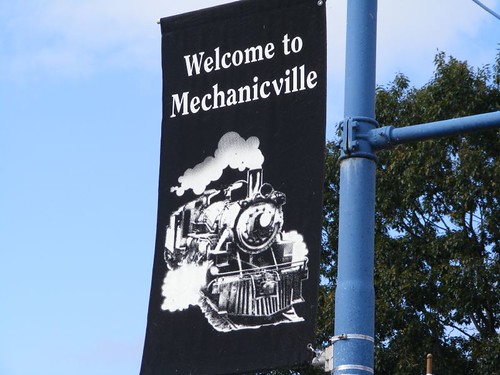October 2-4, 2009
Thinking we had worn out our welcome in Waterford, and not wanting to get back to Florida yet, we decided we would go check out the Champlain Canal. FLUKE would be able to get through the first three locks just like we had for those on the Erie Canal. However, between Lock 3 and 4 there is a bridge that is just a bit too low for us to get under without making special arrangements with the canal operators or removing more pieces from FLUKE to make her another foot lower. If we had the time to go all the way to the end of the Champlain Canal to enter Lake Champlain, we would make arrangements to have the pool lowered. This means that the operator would drain enough water out of the whole area between Locks 3 and 4 until the water was low enough for us to get under that bridge. On a future trip we will probably make that request, but this year we decided to cruise about 10 miles north of Waterford, through the first two locks, and tie up at the terminal wall at a small, cruiser friendly town, named Mechanicville.
The terminal wall has a free pumpout, water, and 30A electric to try to entice cruisers into stopping and visiting the town. There are restaurants, grocery stores, and drugstores all within walking distance. The town has a few original buildings from the old mill days and some nicely kept homes from the late 1800s and early 1900s. It is not a typical tourist town with boutiques or artsy, revitalized areas or is it very picturesque; it is just convenient.
Our first order of business was to pump out. Since I am the one who jumps off the boat and secures it to shore after coming into a wall, I just happened to be conveniently located by the pump out. Rather than insist either of the guys put on their land shoes to go ashore and operate the pump out I said I would do it. Since we had not even seen this kind of a pump out before, there was a lot of “talking” going on between me and the guys about how the thing was supposed to work. I was pleasantly surprised to discover there weren't any odors or stains in the vicinity of the pump or hose. I still used my rubber lock line holding gloves to hand the hose up to Eddie. The instructions seemed straight forward enough. Plus, the guys made sure I read them loud enough for them to hear. I pushed the button, the lights came on, and that pump sucked sewer to the max!! It was one of the cleanest, easiest, and most efficient systems we have used. It was a good way for me to be initiated into the sewer business.
The name Mechanicville came into use in 1829 in reference to the early settlers whose professions such as carpenters or butchers were called the mechanical arts. The town prospered from the canal system boosting commerce to the area, but it derived the biggest benefit from being the center for several railroad exchanges.
Paper was the biggest industry, and in 1904 Mechanicville had the largest paper mill in the world which continued into operation until 1971. An old timer we met on the street talked about how important the mill was to the little community and how many families suffered when the mill moved its operations to Kentucky, where labor was cheaper and tax incentives more lucrative.
Today, Mechanicville can lay claim to fame by having the oldest continuously operating hydroelectric plant in the U.S. It has run 24/7 for more than 100 years! It is located at Lock 3, within sight of the terminal wall where we are docked.
We have been plagued by a cold, dreary, and sometimes wet, weather pattern that has been in the area for about a week now. Those conditions have limited the ability to take many pictures. However, we still get out and walk around, talk to people, and study the town.
One of the information plaques, supplied by the New York State Canal System, explains how terminal walls like the one we are tied to came into existence. When the canal system was being built, many waterside towns realized the benefits that the canal would bring and requested that provisions be made to supply places for barges to tie up to. The 1911 state legislature appropriated $20 million to provide funding for the project with the stipulation that the walls were to be available for all types of public access. Thus, even today, cruisers like us continue to benefit from those laws passed nearly 100 years ago. That just goes to show you that all political legislation isn't useless!
We are all sad to be leaving this area of the state, but know it is time to be making our way south. We will continue to post as time and access permits because I am sure there will be more adventures ahead.
Saturday, October 10, 2009
Subscribe to:
Post Comments (Atom)









0 comments:
Post a Comment